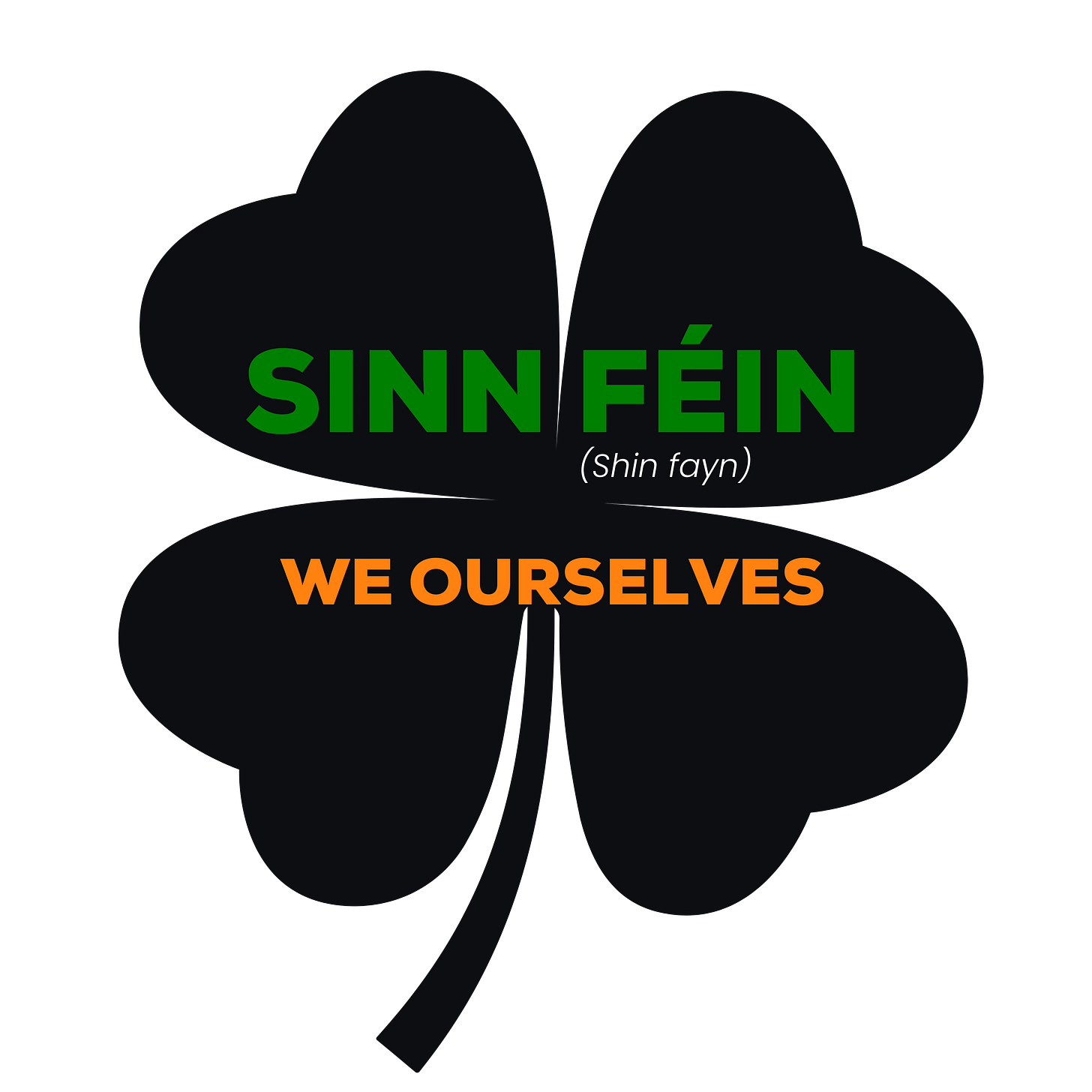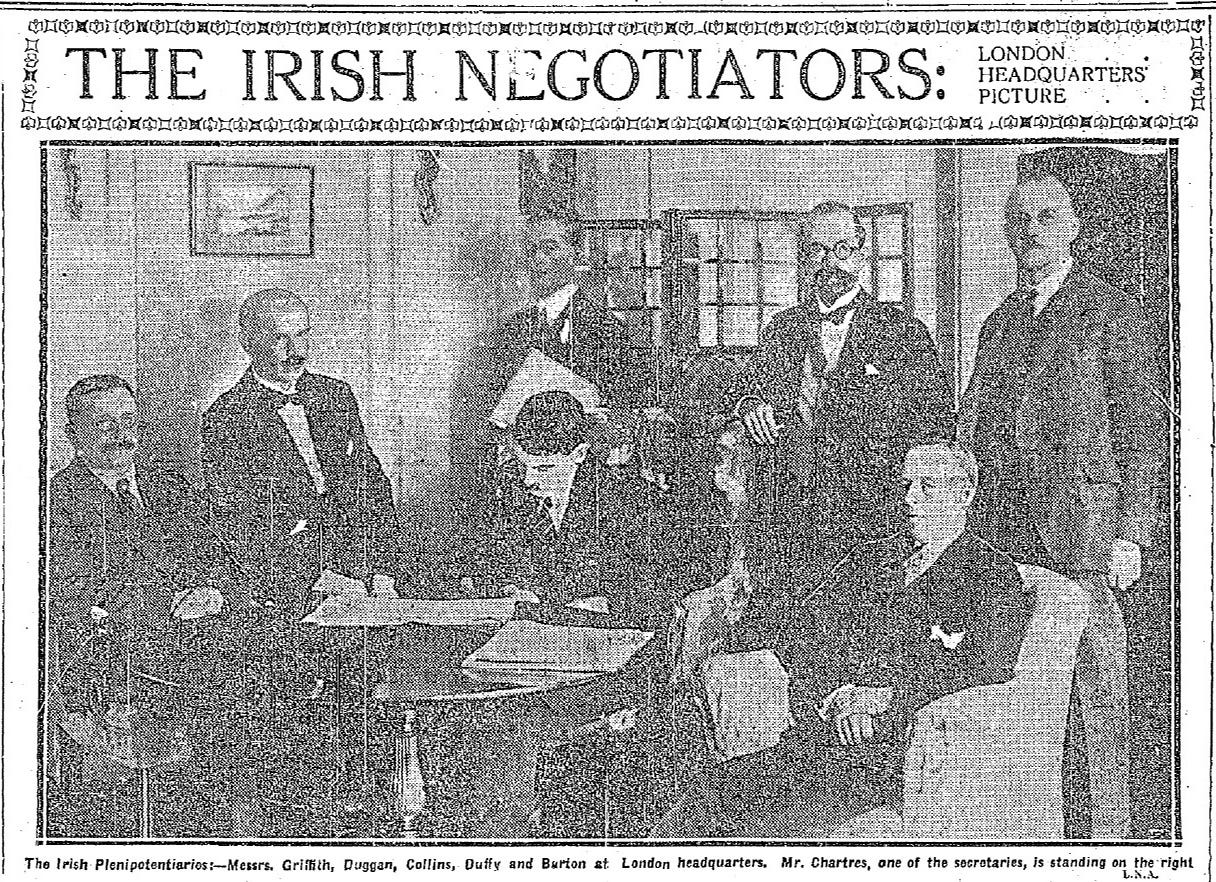Sinn Féin – Resistance, Revolution, and the Fight for Self-Determination
Irish History Through the Lens of Rebellion and Resistance

Last month, I brought you Black History Through the Lens of Liberation, and this month, I bring you Irish History Through the Lens of Rebellion and Resistance—an expansion of the Black history guide because history is not separate, and neither am I.
I share both because I come from both. Knowing your history—not through the oppressor’s lens, but through the lens of your own people—will transform you. It will shape how you move through the world, how you show up in activism, and how you understand resistance as something deeply woven into your very existence.
I am choosing to start this series with Sinn Féin (pronounced shin fayn), because it feels like one of the most powerful declarations of sovereignty I have ever uttered. "We Ourselves."
It is the clearest articulation of a people’s resolve—to govern ourselves, to own our struggle, to refuse subjugation. It hangs in my home as a constant reminder.
So here are more stories of my people—our fight against colonial rule, our refusal to be erased, and our defiant, unbreakable spirit.
With these bloodlines, I am unshakable.
To those who refused to be ruled.
To those who fought, not just with weapons, but with strategy, solidarity, and an unbreakable will.
To those who knew that liberation is never given—it is taken.
This is the story of Sinn Féin, the movement that declared that the Irish people would govern themselves, not as subjects, but as sovereigns.
It is a story of defiance, of struggle, and of why all oppressed peoples—whether in Ireland, the Caribbean, or the United States—must recognize our interconnected fights for freedom.
Because the empire that sought to break Ireland is the same empire that enslaved Black people, that colonized lands, that rewrote history to serve its own myths.
This is not just Irish history.
This is the history of resistance itself.
Sinn Féin: The Name That Meant “Ourselves”
Founded in 1905 by Arthur Griffith, Sinn Féin (meaning “Ourselves” in Irish) was not just a political party—it was a declaration of independence in the face of British rule.
At its core, the movement rejected the idea that Ireland needed permission to govern itself. Instead of working within the British parliamentary systems, Sinn Féin proposed a radical alternative:
🇮🇪 Create an Irish government separate from Britain.
🇮🇪 Refuse to send Irish representatives to British rule in Westminster.
🇮🇪 Build Irish institutions—schools, newspapers, courts, and councils—that answered to the Irish people, not the crown.
This wasn’t just political resistance—it was decolonization in real-time.
Much like Black revolutionaries in the U.S., the Caribbean, and Africa, Sinn Féin understood that true freedom isn’t granted—it is built from the ground up.
And Britain, like all empires, responded the way it always does: with violence.
The 1916 Easter Rising: A Rebellion That Shook the Empire
On April 24, 1916, a group of Irish rebels—many of them connected to Sinn Féin—seized key buildings in Dublin and declared Ireland an independent republic.
This was a turning point.
The Proclamation of the Irish Republic was read aloud (listen here)by Patrick Pearse, declaring an end to British rule.
Armed rebels—many trained by the Irish Volunteers and the Irish Citizen Army—fought against British forces for six days.
The British responded with overwhelming force, shelling Dublin and executing leaders like Pearse, James Connolly, and Thomas Clarke.
The rebellion was crushed.
But the fight was far from over.
Much like Nat Turner’s Rebellion (1831) or the Attica Uprising (1971), the Easter Rising wasn’t just about military victory—it was about planting the seeds of revolution.
It radicalized the people.
It exposed the brutality of the empire.
And it made one thing clear:
🇮🇪 Ireland would not stop fighting until it was free.
The Women Who Fought: The Overlooked Backbone of Irish Resistance
Sinn Féin’s (shin fayn) history is often told through the lens of men—Arthur Griffith, Michael Collins, Éamonn Ceannt. But Irish women were the lifeblood of the revolution, organizing, strategizing, and fighting just as fiercely for freedom. Much like the Black women who have always been at the center of liberation struggles, Irish women were the unseen forcebehind the movement.
Constance Markievicz – A revolutionary, suffragist, and soldier, born in Sligo (my family of origin town) she fought in the 1916 Easter Rising and became the first woman elected to the British Parliament—though she refused to take her seat under British rule. She later became the first female cabinet minister in Europe, proving that women were not just foot soldiers in the fight—they were leaders.
Kathleen Clarke – After the British executed her husband, Thomas Clarke, for his role in the Easter Rising, she continued his revolutionary work, becoming a key Sinn Féin leader and the first female Lord Mayor of Dublin.
Cumann na mBan – The women’s paramilitary wing of the Irish Volunteers. These women didn’t just support the fight—they smuggled weapons, trained in combat, nursed the wounded, and acted as spies. Some even died in battle, yet history often relegates them to the background.
Margaret Skinnider – A sniper during the Easter Rising, she was wounded in combat and denied a military pension because the Irish government claimed that “women could not be soldiers.” Yet she led armed resistance against the British.
Winifred Carney – A trade unionist and suffragist, she was James Connolly’s secretary and fought in the General Post Office during the Easter Rising, armed with a typewriter and a revolver.
Much like Black women in resistance movements—Fannie Lou Hamer, Angela Davis, and Ida B. Wells—Irish women were the foundation of the revolution, yet their names are often footnotes.
Reflection: How do we ensure that women’s contributions to liberation struggles are fully recognized and honored?
Sinn Féin and the War for Irish Independence (1919–1921)
After the Easter Rising, Sinn Féin surged in power.
In the 1918 elections, Sinn Féin won a landslide victory—but instead of taking seats in the British Parliament, they did something revolutionary:
They formed their own Irish government, the Dáil Éireann, in open defiance of British rule.
This sparked the Irish War of Independence (1919–1921), led by Michael Collins and the Irish Republican Army (IRA).
This was not just about warfare—it was about building a new nation while fighting an old empire.
Sinn Féin’s government created:
Courts that ruled under Irish law.
A press that spread Irish news, not British propaganda.
Economic policies that prioritized Irish industry.
It was a full-scale rebellion—political, cultural, and military.
And it worked.
In 1921, Britain was forced to sign the Anglo-Irish Treaty, giving Ireland partial independence.
But this victory came at a cost
Division, Civil War, and the Fight for a United Ireland
The Treaty divided Ireland, creating the Irish Free State while keeping six counties in the North under British control—what we now call Northern Ireland.
This split led to civil war (1922–1923), pitting Irish nationalists against one another.
Sinn Féin rejected the treaty, refusing to accept anything less than a fully independent Ireland.
The scars of this division still exist today.
But through every battle, through every betrayal, Sinn Féin has remained at the center of the fight for a united, free Ireland.
The Black-Irish Connection: Why This History Matters to Black Liberation
At first glance, the struggle for Irish independence and the fight for Black liberation might seem like separate battles.
But look closer.
The same empire that colonized Ireland enslaved Black people.
The same police forces that brutalized the Irish became the model for American policing.
The same tactics used to suppress Irish rebellion were used against Black revolutionaries.
And so, across history, our movements have intersected.
Frederick Douglass found inspiration in Irish freedom fighters.
The Black Panthers studied the IRA’s tactics of resistance.
Bobby Sands, an IRA prisoner, wrote of his solidarity with oppressed Black people worldwide.
Our struggles have always been connected.
Because white supremacy is global—so our resistance must be, too.
Reflection: Who Are Today’s Revolutionaries?
The Irish fight for independence didn’t end with Sinn Féin.
The Black liberation struggle didn’t end with the Civil Rights Movement.
So the question is:
Where are we still fighting for freedom today?
Who are the modern revolutionaries challenging systems of oppression?
How can we recognize that liberation anywhere strengthens liberation everywhere?
Because empires fall.
They always do.
And those who fight for justice will outlast them all.
Further Learning: Watch, Read, and Experience
📺 Watch:
The Wind That Shakes the Barley (2006) – A powerful film about the Irish War of Independence.
Bobby Sands: 66 Days (2016) – A documentary on the IRA hunger strikes of 1981.
📖 Read:
We Want Freedom: A Life in the Black Panther Party by Mumia Abu-Jamal – Draws parallels between Black and Irish resistance.
Ten Men Dead by David Beresford – A gripping account of the Irish hunger strikes.
🎭 Experience:
Visit Kilmainham Gaol in Dublin, where Irish revolutionaries were imprisoned and executed.
Research how Black and Irish activists have worked together in liberation movements. The long, storied history of solidarity between Black and Irish activists
A 28-Day Journey Through Resistance and Liberation
The story of Sinn Féin is part of a much larger history of resistance—one that spans continents, movements, and generations.
It’s part of my 28-Day Journey Through Resistance and Liberation, a living document that continues to grow.
✊🏾 Join the journey today: Get the guide here
Conclusion: The Fight Is Not Over
Sinn Féin’s name means “Ourselves”—because that is who liberation has always depended on.
Not the government.
Not the empire.
Not the oppressors.
Ourselves.
And that is true in Ireland.
That is true in the United States.
That is true anywhere people refuse to be ruled.
Because history has shown us one thing:
Empires fall.
But the people?
We rise.
In solidarity and liberation,
Desireé B. Stephens CPS-P
Educator | Counselor | Community Builder
Founder, Make Shi(f)t Happen






Thank you for writing this, Desireé! I have primarily Irish and Scottish ancestry though I’ve been cut off from that cultural heritage (except for what I’ve learned on my own), and I’ve often felt that everything white supremacist empires (and their colonization) have done to the rest of the world we (white folks of European descent) did to other Europeans (ourselves) first. My cultural heritage was not passed down to me because the British empire tried to erase those cultures, and in my family lines it was lost. I've struggled to articulate that feeling and also struggled to know what to do with that feeling. Amalgamated "white culture" here in the US is so often seen as bland, boring, vanilla—like a kind of non-culture—and to the extent that's true, it seems to be true largely because our own indigenous cultures were systematically eradicated. As someone whose true cultural heritage has been replaced with a "non-culture" it seems potentially useful to sit with the pain of that loss as a means of finding a way into the experiences of indigenous peoples of color and the devastation they have faced at the hands of white colonization. And as you say, to recognize this shared history of resistance where (from my perspective) whiteness has often felt somewhat othering in the space of resistance work here in this country. Both because of white supremacist oppression (obviously) and because of the failures of white folks (white feminists for example) to stand shoulder to shoulder with Black and Brown activists. All of which is to say, again, thank you so much for your work and for sharing your wisdom with the world.
Great work! I just posted a link to this on Bluesky: https://bsky.app/profile/kevinhing.bsky.social/post/3ljkerpnz522l.